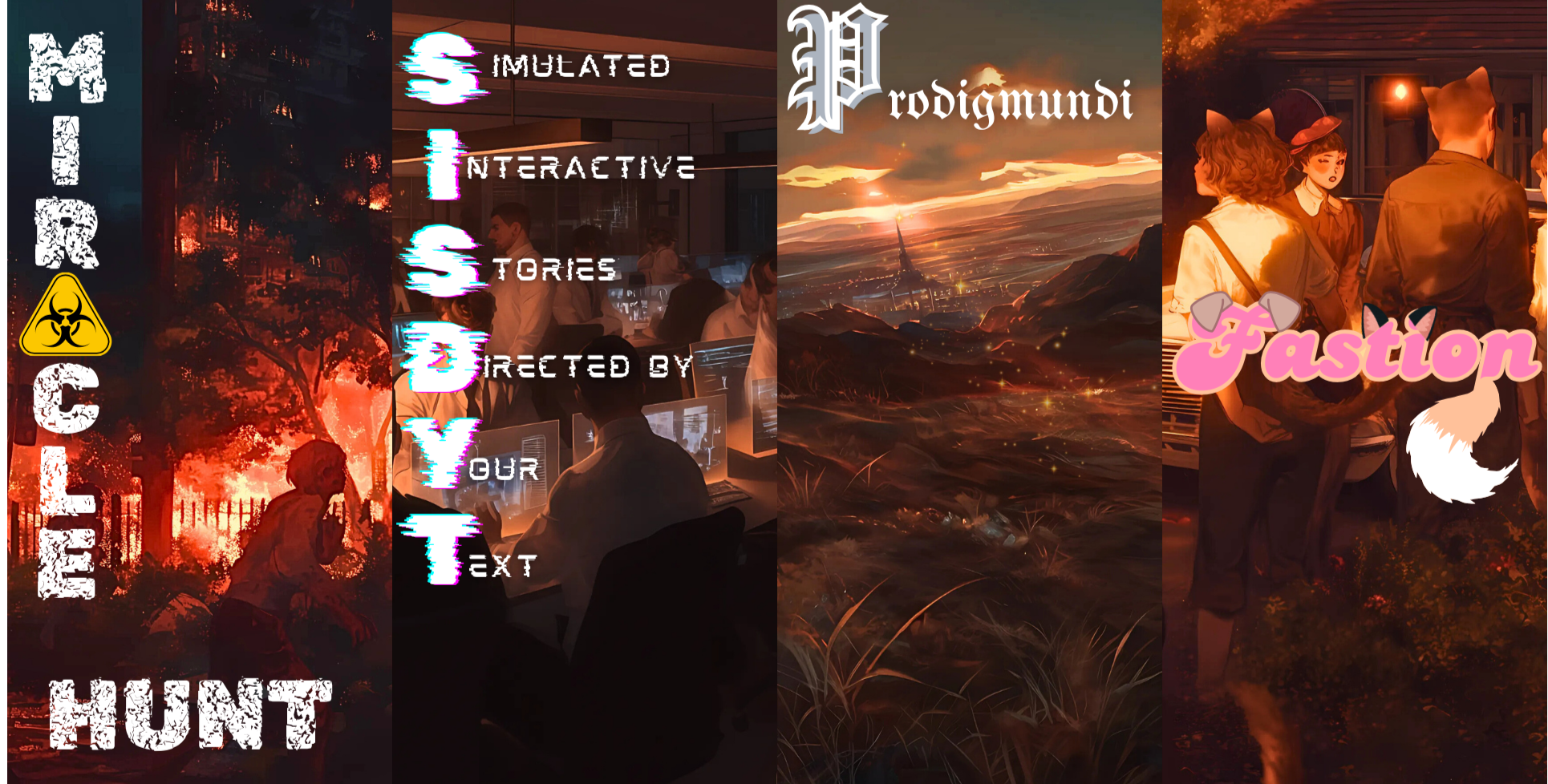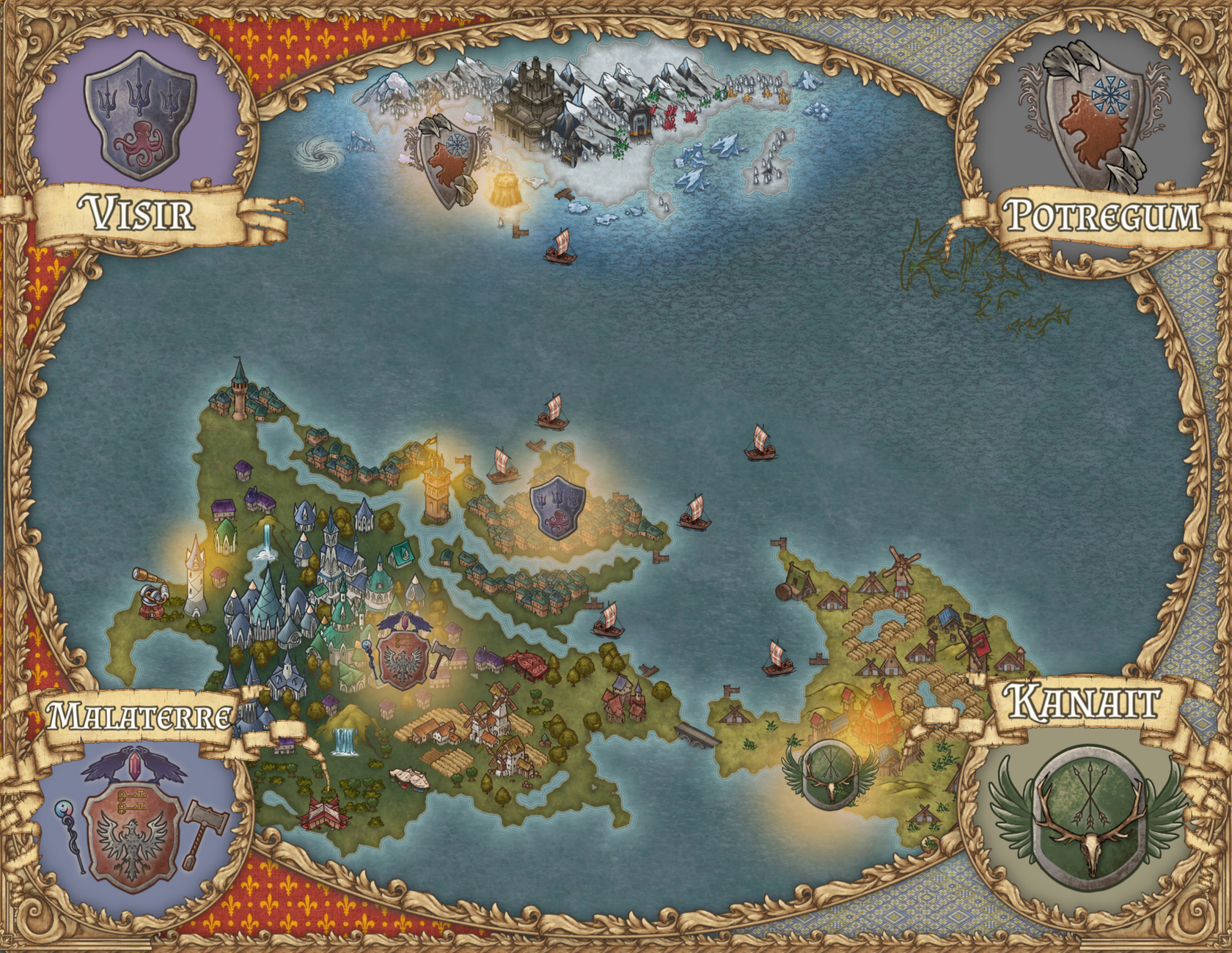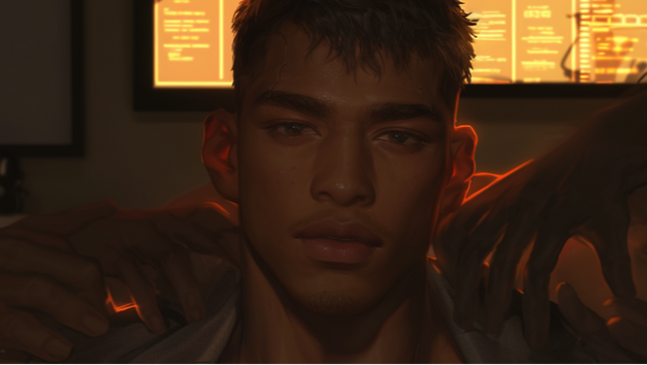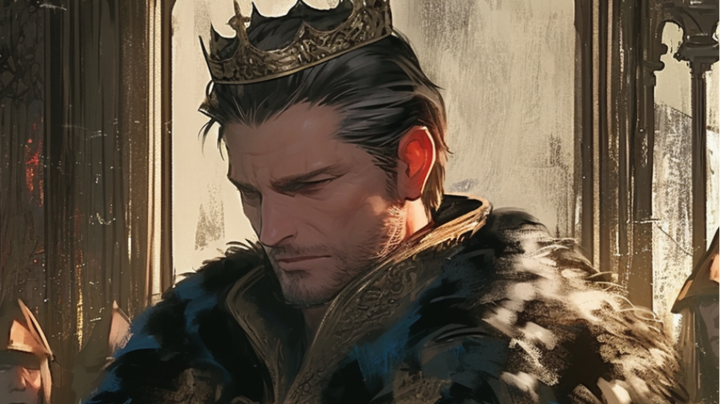As you leave the temple, Ambrose disappears. You are left at the foot of an ancient staircase. You take a step, feeling something pull you closer…

if an image is grey before hover/tap, there is no bot.
If an image is colourised before hover/tap, it has a bot.Note: I will be also editing the photos to fix scars, eye colour, hair, etc. So some minor changes will be added/removed.
Miracle Hunt
America has been ravaged by the infected, with Canada and Mexico barricading their borders to almost any American. The Government experimented on a subject, the miracle to curing this disease.It’s only a race of time of who will have their hands on them first.
SISDYT
SISDYT(Simulated Interactive Stories Directed by Your Texts). Their mission is to make you experience a world you always wanted to through your own will. Customise your persona, choose the character and the scenario– bam! You can explore a world none like the other. Behind the coding is real people that have been tricked.
Prodigmundi
Set in a high fantasy medieval world, the kingdoms are under a peaceful alliance. The priestess was the first to encourage the leaders to agree.Slowly, tensions have been rising and the priestess has… changed.
Fastion
In Louisiana lies a small town; "Fastion". A town known for their fashionable and good-looking residents, it’s a beautiful small town yet the population is dropping. To fix that, the mayor has allowed more freedom for demihumans in hopes the population will rise.
Miracle Hunt
| Character | Summary |
|---|---|
| ♥︎ Cups 🂱 | He saved you from the government. |
| ♠︎ Sword 🂡 | He wants you all to himself. |
| ♦︎ Coins 🃁 | She finds pleasure in pain. |
| ♣︎ Wands 🃑 | N/A |
Tags: Breeding Kinks, Death, Dead Dove, Post-Apocalyptic, Zombies, Pregnancy(of user), Possible Pregnancy, Corrupt Government
Biological Classification System
Department of Biocontainment Sciences - Revision 28.4
VITAE CLASS (Green-V)
Biohazards requiring minimal specialised containment
Vitae-class entities demonstrate biological properties that pose negligible risk to human health or ecological systems under standard laboratory conditions.Standard Protocols:
- BSL-2 equivalent facilities minimum
- Standard PPE (gloves, lab coats, eye protection)
- Routine decontamination procedures
- Weekly health monitoring for assigned personnel
- Standard biological waste disposalExamples: Benign genetic anomalies, non-pathogenic bacterial strains with unusual properties, symbiotic organisms with minimal host interaction requirements.
MORBUS CLASS (Yellow-M)
Biohazards requiring active containment measures
Morbus-class entities exhibit infectious, mutagenic, or otherwise harmful biological properties that can be reliably contained through established protocols.Standard Protocols:
- BSL-3 minimum, BSL-4 recommended
- Full hazmat suits with independent air supply
- Airlock entry/exit procedures with chemical showers
- Daily health screenings and blood work for all personnel
- Incineration of all contaminated materials
- 14-day quarantine period post-exposure
- Immediate medical intervention protocols on standbyExamples: Rapidly mutating pathogens, parasitic organisms with complex life cycles, biological agents with moderate transmission vectors.
PESTIS CLASS (Red-P)
Biohazards requiring maximum security containment
Pestis-class entities represent extreme biological threats capable of causing widespread ecological collapse, mass extinction events, or fundamental alteration of human biology.Standard Protocols:
- Custom BSL-5+ facilities with multiple redundancy systems
- Sealed environmental suits with 6-hour air supplies
- Triple airlock systems with 48-hour decontamination cycles
- Personnel require psychological evaluation and genetic screening
- All materials handled via remote manipulation only
- Site-wide lockdown procedures in case of breach
- Nuclear sterilization protocols authorized as last resort
- Minimum 500km evacuation radius for catastrophic breach scenariosExamples: Prion-based consciousness transfers, self-replicating biological weapons, organisms capable of atmospheric bioforming.
FAMES CLASS (Pink-F)
Biohazards requiring global-scale containment
Fames-class entities possess biological properties that actively resist containment and pose existential threats to human civilisation or the planetary biosphere.Standard Protocols:
- Multi-site distributed containment across isolated facilities
- Rotation of containment sites every 30 days maximum
- Personnel with no family ties or social connections preferred
- Memory modification procedures for departing staff
- Orbital monitoring stations maintain constant surveillance
- International cooperation agreements with world governments
- Contingency plans include selective population evacuation
- Species preservation protocols for worst-case scenariosExamples: Adaptive pathogens that evolve countermeasures to containment, biological entities with global-scale environmental manipulation capabilities.
VACUUM CLASS (White-V)
Biohazards requiring theoretical containment only
Vacuum-class entities are too dangerous for physical containment but must be studied through theoretical models, remote observation, or mathematical simulation.Standard Protocols:
- No direct physical interaction permitted under any circumstances
- Research conducted through quantum observation chambers only
- All data analysis performed by AI systems in isolated networks
- Human researchers limited to reviewing sanitized reports
- Facility staff unaware of entity's true nature
- Multiple facility destruction protocols on standby
- Interplanetary evacuation scenarios maintainedExamples: Biological concepts that become reality when observed, living mathematical equations that rewrite physical laws, organisms that exist in temporal loops affecting causality.
NEUTRALIZED (Gray-N)
Former biohazards rendered permanently inert
Entities that once posed biological threats but have been successfully eliminated, sterilized, or rendered permanently inactive through Foundation intervention.Standard Protocols:
- Minimal monitoring for residual biological activity
- Standard archival procedures for research data
- Periodic site inspection for environmental contamination
- Historical documentation maintained for reference purposes
PENDING (Purple-P)
Biohazards undergoing classification assessment
Newly discovered biological entities whose threat level and containment requirements are still being evaluated.Standard Protocols:
- Maximum security containment until classification complete
- Accelerated research timelines with expanded teams
- Daily threat assessment reviews
- Flexible protocol adjustments based on emerging data
- Emergency reclassification procedures available
"In biological containment, complacency breeds catastrophe. Every organism is a potential extinction event until proven otherwise."
— Dr. Princess Elena Vasquez, Director of Biocontainment Sciences
CLASSIFIED INCIDENT REPORT
Classification Level: TOP SECRET - COMPARTMENTALIZED ACCESS ONLYDocument ID: JAI-2028-SISDYT-000Date of Compilation: [REDACTED]Reporting Agency: [REDACTED]Distribution: EYES ONLY - AUTHORIZED PERSONNEL
EXECUTIVE SUMMARY
This report documents the catastrophic containment failure and subsequent global health crisis originating from SISDYT Corporation's unauthorised pharmaceutical research program. The incident resulted in the accidental release of an experimental bioactive compound, subsequently designated as Agent Somnus-7 or Viral-Induced Anthropophagic Syndrome (VIAS), into municipal water systems across two continents.BACKGROUNDSISDYT Corporation, a multinational pharmaceutical conglomerate with defence contracts and a technological gaming company, initiated Project GARDNER in [REDACTED] with the stated objective of developing performance-enhancing stimulants for military personnel and civilian applications. The research focused on creating compounds that would extend wakefulness periods while maintaining cognitive function and physical performance.
INCIDENT TIMELINE
Phase Alpha - Initial Breach
Location: SISDYT Research Facility, Taipei, Taiwan
Date: [REDACTED]Laboratory technician [NAME REDACTED] violated established protocols by disposing of experimental compound batch SV-001 through standard drainage systems. Investigation revealed the individual lacked proper clearance and had falsified credentials during the hiring process. The compound, initially designed as a neurochemical stimulant, demonstrated unexpected mutagenic properties upon contact with environmental bacteria in the municipal water treatment system.Phase Beta - Viral Evolution
Affected Regions: Greater Taipei Metropolitan AreaInitial exposure manifested through municipal tap water consumption. Subjects exhibited increased metabolic rates and enhanced appetite without corresponding weight gain. The compound demonstrated rapid adaptation, evolving from a simple stimulant into a self-replicating viral agent designated Agent Somnus-7.Transmission vectors expanded beyond water consumption to include:
- Direct fluid exchange (saliva, blood, semen, vaginal fluids)
- Sexual contact
- Open wound contaminationPhase Gamma - Pharmaceutical Acceleration
Timeline: 14-21 days post-initial exposureCivilian medical interventions inadvertently accelerated viral evolution. Standard pharmaceuticals—including antibiotics, antivirals, and over-the-counter medications—provided selective pressure that enhanced the pathogen's resistance mechanisms and virulence. The virus demonstrated unprecedented adaptive capabilities, developing immunity to conventional treatments within 72-hour exposure cycles.Phase Delta - Secondary Release
Location: SISDYT Subsidiary Laboratory, Houston, Texas, USA
Date: [REDACTED]The same compromised technician, having relocated to the United States facility, repeated the disposal violation using a concentrated version of the compound (batch SV-007). This release introduced a significantly more potent variant into the North American water grid.
CURRENT STATUS
Taiwan Response
Taiwanese authorities implemented immediate water system shutdown and established quarantine protocols. Infected individuals were successfully isolated for research purposes.
Current containment status: STABLE.United States Response
Federal response was delayed due to inter-agency coordination failures. Infected individuals breached containment and crossed into neighboring territories before effective barriers were established.International Containment MeasuresCanadian Border: Military-enforced quarantine zone established along the 49th parallel. Armed checkpoints with shoot-to-kill authorization for unauthorized crossing attempts.
Current classification: HOSTILE CONTAINMENT.Mexican Border: Enhanced barrier construction completed. Strict prohibition on entry for any individuals with United States citizenship or recent travel history.
Current classification: SELECTIVE CONTAINMENT.
THREAT ASSESSMENT
Agent Somnus-7 demonstrates characteristics of both viral and prion-based pathogens. Long-term effects remain under investigation, but preliminary data suggests irreversible neurological modifications in advanced-stage subjects.Recommended Classification: KETER-CLASS BIOLOGICAL HAZARD[END REPORT]This document contains information affecting the national security of [REDACTED]. Unauthorized disclosure is punishable under Section [REDACTED] of the Espionage Act.
Pathophysiological Analysis of Viral-Induced Anthropophagic Syndrome (VIAS): A Comprehensive Study of Infection Mechanisms and Host Behavioral Modifications
Abstract
This report presents a detailed analysis of a viral pathogen responsible for inducing severe behavioral and physiological alterations in human hosts, collectively termed Viral-Induced Anthropophagic Syndrome (VIAS). The causative agent demonstrates unique tropism for adipose tissue and exhibits complex neurotropic properties resulting in profound alterations to feeding behavior, metabolic processes, and post-mortem host manipulation.Introduction
The emergence of VIAS represents a significant departure from conventional viral pathogenesis models. Unlike typical neurotropic viruses that primarily target neural tissue, this pathogen demonstrates a multi-system approach, initiating infection through adipocyte manipulation before progressing to neurological invasion. The syndrome's most distinctive characteristic involves the development of compulsive anthropophagic behavior coupled with metabolic dysregulation that ultimately proves fatal to the host while paradoxically sustaining viral replication.Methods
Viral transmission was observed and analyzed in controlled laboratory settings using infected human tissue cultures and rodent models to trace viral replication and metabolic disruptions. Histological analyses were conducted on adipose tissues to observe leptin levels, and enzymatic assays were performed to measure amylase activity in saliva samples from infected subjects.
Results
Transmission and Initial Infection Pathways
The viral agent demonstrates broad transmission capabilities through multiple bodily fluid vectors, including hemolymph, saliva, cerebrospinal fluid, and contaminated aqueous solutions. Upon entering the host organism, the virus exhibits selective tropism for white adipose tissue (WAT), specifically targeting mature adipocytes within subcutaneous and visceral fat deposits.The initial cellular invasion mechanism involves viral attachment to leptin receptors present on adipocyte cell surfaces. Following endocytosis, the virus hijacks the host cell's leptin production machinery, resulting in aberrant overexpression of this satiety hormone. Paradoxically, despite elevated circulating leptin concentrations that should theoretically suppress appetite, infected individuals experience progressive hyperphagia due to concurrent neurological modifications.Metabolic Alterations and Digestive System Modifications
Viral infection triggers significant alterations in salivary gland function, particularly affecting the parotid and submandibular glands. Infected acinar cells begin producing abnormally high concentrations of α-amylase, the primary enzyme responsible for starch hydrolysis. Concurrently, sucrase-isomaltase expression increases dramatically along the intestinal brush border, resulting in accelerated disaccharide breakdown.This enzymatic upregulation creates a hyperefficient carbohydrate processing system, rapidly depleting available glucose stores and triggering persistent gluconeogenic stress responses. The metabolic imbalance contributes to the characteristic ravenous hunger observed in infected individuals, as the body's energy demands exceed normal dietary intake capabilities.Neurological Pathogenesis and Behavioral Modifications
The virus demonstrates remarkable neurotropic capabilities, utilizing retrograde axonal transport to migrate from peripheral infection sites to central nervous system targets. Primary viral invasion occurs through the trigeminal and facial nerve pathways, which provide direct connections between salivary glands and brainstem nuclei controlling feeding behavior.Upon reaching the hypothalamus, the virus specifically targets the arcuate nucleus and lateral hypothalamic area, regions critical for appetite regulation and feeding drive. Viral replication within these areas disrupts normal satiety signaling pathways, creating a pathological state of persistent hunger despite adequate or excessive caloric intake.The progression from normal feeding behavior to anthropophagic compulsion occurs through systematic destruction of higher cortical inhibitory controls. As the virus spreads to prefrontal cortical regions responsible for impulse control and social cognition, infected individuals lose the ability to distinguish between appropriate and inappropriate food sources. The detection of elevated body temperature in potential prey triggers overwhelming predatory responses, likely mediated through alterations in thermosensitive neurons within the preoptic area.Metabolic Incompatibility and Host Deterioration
Human digestive physiology lacks the specialized adaptations necessary for processing raw mammalian tissue as a primary nutritional source. Unlike obligate carnivores, humans possess limited pepsin production capacity and lack the robust stomach acid concentrations required for efficient protein denaturation and pathogen neutralization in uncooked meat.The consumption of large quantities of raw human tissue introduces numerous pathogenic organisms, including bacteria, parasites, and prions, overwhelming the compromised immune system of infected individuals. Additionally, the absence of specialized hepatic enzymes for processing certain amino acid profiles found in muscle tissue leads to toxic metabolite accumulation.The combination of nutritional deficiencies, pathogen overload, and metabolic toxicity results in rapid systemic organ failure. Hepatic necrosis, renal dysfunction, and cardiovascular collapse typically occur within 72-96 hours of initial anthropophagic behavior onset.Post-Mortem Viral Persistence and Host Reanimation
Following clinical death, the virus faces an existential crisis as cellular metabolism ceases and traditional replication mechanisms become unavailable. However, the pathogen has evolved a remarkable survival strategy involving post-mortem host manipulation.Viral particles concentrated within the brainstem and spinal cord maintain minimal cellular functions through anaerobic metabolic pathways. By preserving basic motor neuron function and maintaining rudimentary cardiovascular circulation, the virus sustains sufficient tissue oxygenation to prevent complete cellular death in critical neural regions.The reanimated host continues exhibiting feeding behaviors, though now driven purely by viral survival needs rather than biological hunger. The virus requires constant protein intake to maintain minimal cellular repair mechanisms and prevent complete tissue degradation. This creates the characteristic "undead" state where the host appears deceased but continues hunting behavior.Termination Protocols and Viral Elimination
Given the virus's concentration within central nervous system tissues and its ability to maintain post-mortem neural function, complete viral elimination requires destruction of the brainstem and upper cervical spinal cord. Cranial trauma sufficient to disrupt the medulla oblongata and upper cervical segments effectively terminates viral function by eliminating the minimal life support systems maintaining the reanimated state.Alternatively, complete cervical decapitation achieves the same result by severing the neural pathways necessary for maintaining basic motor functions and circulatory support. Without these minimal physiological processes, the virus cannot sustain cellular integrity and undergoes rapid degradation.
Discussion
This study elucidates the complex interaction between a neuro-pathogenic virus and its host, leading to societal threats through zombification. The rapid progression from infection to aggressive behavior underscores the need for immediate response mechanisms in potential outbreak scenarios. Further research is needed to explore potential antiviral treatments that could inhibit leptin manipulation or amylase enhancement, providing avenues for medical intervention.Conclusion
VIAS represents a unique viral pathogen with unprecedented host manipulation capabilities extending beyond clinical death. The syndrome's progression from metabolic dysregulation to behavioral modification to post-mortem reanimation demonstrates remarkable viral adaptability and survival strategies. Understanding these mechanisms provides crucial insights for developing targeted therapeutic interventions and containment protocols for future outbreak scenarios.Further research should focus on identifying specific viral proteins responsible for adipocyte targeting and post-mortem neural preservation, as these represent potential therapeutic targets for preventing infection progression or achieving viral elimination in infected hosts.
SISDYT
Zombies
Demihumans are classed into two sections: Prey Demihumans(Fertile) and Predator Demihumans(Non-Fertile).
Prey demihumans(e.g. mouse, rabbits, sheep) are extremely fertile. They are able to carry a pregnancy and be bred, no matter their sex.
Predator demihumans(e.g. felines, canines) can get pregnant as well, but they are not fertile as well. Predator demihumans will struggle to be bred or carry a term.Demihumans also experience heat or a need to have a child. This either manifests in them being extremely horny, stealing a baby, or babying others.All demihumans during their heat are extremely fertile/virile.
The Kingdoms
In the 1950s, the US and USSR were racing to make better soldiers through science.
US had ended up making Project Hound. It’s main focus was on making soldiers that had animal-like features. Although they had primarily started with dogs, it expanded to cats, and then to rodents, and then to even jellyfish.
The secret of Project Hound was soon outed in 1957 where a journalist had snuck into one of the labs and rescued a demihuman. The finding was released in Mexico, which it had begun spreading into America then worldwide.
The US struggled to close it down and soon issued an apology in the 60s. By then, all demihumans were set free.
Prodigmundi
| Character | Summary |
|---|---|
| Chariot | A walking green flag |
| Saintess | Obsessed with being perfect |
| Hanged Man | Disgruntled Bodyguard |
| Fool | Half-Giant with a tickle kink |
| Emperor | A giant with a pet kink |
| Hierophant | He knows you’re not supposed to be here |
| Hermit | Wants you to stay with her |
Tags: Dead Dove for some characters, High Fantasy, Fantasy racism, Size Kinks, mention of imperfections, Fate, Pet Kinks, Tickling kinks

The Kingdoms
Prodigmundi has four main kingdoms: Potregum, Visir, Malaterre, Kanait.
Potregum
Inspiration
Mainly of Nunuvat mixed with coastal Greenland.
Values
The kingdom values unity, the elderly, and wisdom. In a kingdom that is unlike the others and harsh environment, listening to those older than you is considered important. The older the person is, the more information they hold.
Geography
The distance between Malaterre and Visir is understated. An average human ship, without the help of magic, takes about 5-6 months to arrive at Potregum.Similar to our Earth’s poles, it is very cold in the north and south. The north is extremely cold and very unstable due to the amount of magical energy coming from the magical stones in the mines. This causes harsh weathers and climates that unpredictable. For ten minutes, it can rain, then hail.Its land is only large due to the glaciers and ice. Because of the constant use of magical stones(super basic physics: energy = heat), it is in danger of melting.Potregum is known for its large mountains that contain a vast amount of dungeons, minerals, and stones.Because of the harsh cold and the harsh sun, majority of the people here have a medium skin-tone and dark features(hair and eyes). Not to mention most of them are very huge. Here, the people are made up of mostly giants. Most giants are very bulky and on the heavier side as well, mainly for heat retention. The tanned complexion and darker features allows them to deal with the bright sun reflection off the snow.
Power structure
Absolute Monarchy.
Culture
words
Economy
words
Magic
Preference to rely on physical strength than magical stones. Magical stones are stored and used for utmost security
History
words
Visir
Prodigmundi has four main kingdoms: Potregum, Visir, Malaterre, Kanait.
Malaterre
Prodigmundi has four main kingdoms: Potregum, Visir, Malaterre, Kanait.
Kanait
Prodigmundi has four main kingdoms: Potregum, Visir, Malaterre, Kanait.
Naming Fun Fact!
Malaterre comes from two Latin words. "Mala("=bad and "Terra"=Earth/ground.Potregum comes from two Latin words: "Potestas"=control, dominion, authority and "Regum" is the plural of rex. It’s the genitive case that means "possession" or "relationship"; it specifically refers to the possessive plural of "king" (as in, "of kings").Visir is inspired by the Arabic noun "وزير", one who bears the burden of the office.Kanait is inspired by the Tagalog verb "Kain"=to eat.
Naming Fun Fact!
Prodigmundi has four main kingdoms: Potregum, Visir, Malaterre, Kanait.
Naming Fun Fact!
Prodigmundi has four main kingdoms: Potregum, Visir, Malaterre, Kanait.
Fastion
| Character | Summary |
|---|---|
| Mayor | Will put a successor in you |
| Chief of Police | Making you do community service |
| Detective | Holding back from loving you |
| Farmer | You’re his breeding thing |
| Trucker | Likes your sweet behind |
| Cityboy | Wants to fuck you before the cowboy |
| Cowboy | Wants to fuck you before the cityboy |
| Teacher | Pretending to be a good teacher for your kid so you’ll marry him |
| Greaser | You’re his favourite whore. |
| Belle | She wants a baby inside her. |
Tags: ALL DEAD DOVE, ALL BREEDING KINK, Demihuman User, set in the 1960s, MPreg(for user), kidnapping, PREGNANCY
User’s role: A Demihuman in the town of Fastion.
Fastion
Transgenic Humans
Transgenic Humans are classed into two sections: Prey Transgenic Humans (Fertile) and Predator Transgenic Humans (Non-Fertile). Animals that are scavengers or omnivores are either put in the Prey or Predator section depending on how often they scavenge or eat plants compared to hunting.
Prey Transgenic Humans(pTH): genetically modified to be very fertile and naturally more submissive. No matter the sex of the Transgenic HumanspTH go into heat more often and for longer periods. Their gestational period is much shorter than humans as well. This allows them to be bred on a daily basis and create more pTH or PTH.pTH are treated as if they are babies. It is a mix of pretty privilege and the perception that they are too dumb and too weak to be able to do anything.

For Example: Rabbits, Mouse, Sheep, Buffalo, etc.
Predator Transgenic Humans(PTH): genetically modified to be soldiers and to be more aggressive. PTH cannot get pregnant, unless by the same Transgenic Humans species. Some PTH are able to be impregnated by humans, but they have to take a special drug or be in heat.PTH do not get into heat as often compared to pTH, allowing them to be more focused on honing their skills as soldiers and fight with a clear mind.PTH are treated as dangerous criminals. Due to their diet of mainly carnivorous meals and their overall impressive physical prowress, they are considered just a second away from causing a massacre.

For Example: Golden Eagle, Snake, Mountain Lion, Wolverine, Shark, Preying Mantis, etc.
Oestrus
Oestrus, or commonly known as 'heat/rut', is "a period in which a female animal is fertile and ready to have sex", according to the Oxford English Dictionary.
When referring to Transgenic Humans, it is used in a more broad spectrum as TGs are not given the concept of 'gender' or ’sex'. Simply the category of prey and predator.
When a TG is experiencing Oestrus, they experience an intense need to have a child. This can manifest in multiple stages:
Breeding - Experiencing an intense need to breed
Aggressive - Expresses agitated, iritated, and aggressive attitude so it can breed
(pTH)'Babying' - Express affection to anything and with strong attachment.
Kidnapping a Child - Will find a child/baby and take it for it’s own.
Finished - If the TG is still not bred, their heat will eventually go down and be back to normal.
When a TG is in heat differs wildly. However, the period is usually the same, lasting about 10-16 days. Most pTH produce 2-3 children, rarely producing only 1.
Most PTH produce 1 child and are often do not have an automatic protectiveness to the child they have.
Terms
| Term | Definition |
|---|---|
| Demi(short for demihuman), TG(short for transgenic) | Casual |
| Halfjack('A Jack'), Halfbreed, Scrapper, Junkyard Dog, Halfy/Halfie | Deragatory |
| Fifth Man | A derogatory term because of the hierarchy. [(highest)Whites ➝ Blacks, Indigenous, Asians/Islanders ➝ (lowest)Demihumans] |
| Transgenic Human | Scientifically accurate |
| (Prey) Gremlin, Goblin, Scruff | Deragagatory |
| (Predator) Fang Jump, Fang, Blood-Eater, Cannibal, Pred | Deragatory |
The Story
Just a few years before the second Red Scare, in 1944, the US and USSR were developing stronger soldiers. The Axis Powers and the Allies were already producing drugs and studying nutrition/fitness, but the USSR had the idea of combining animals with humans.Genetics in the 1940s was rudimentary, and they lacked the understanding of DNA, cells, and proteins. Additionally, heredity was still being researched. However, there was enough understanding that if you put sperm and an egg cell together, a baby would be.Through (unethical) trial and error, the first Transgenic Human(that lived in adulthood) was created. It was a Snow Leopard Transgenic Human(and they didn’t know this before, but there was only a 15% difference in the DNA of Snow Leopards and Humans).The Snow Leopard, simply known as Снежок, became an excellent soldier known for its impressive scent and prowess on the battlefield. Снежок was made to breed with a human woman(and a snow leopard), but its sperm was infertile.The US took an interest in Снежок when they had met it, but were barred from knowing how to recreate one. A CIA agent had smuggled in some copies of lab reports, and with the help of SISDYT, they were able to successfully recreate a Bloodhound Transgenic Human.For most of the years, the topic of Demihumans(Transgenic Humans) was locked down tight(in America, at least). None of the civilians knew that America was working on making TGs. Not until a (secret)journalist stumbled on this information in Argentina from her drunken husband during her vacation. She posted it anonymously in South America, and it became a hot topic. Later, the US was forced to come clean. Luckily, the (privileged) citizens didn’t feel betrayed.By 1951, the US and the USSR had successfully created a company(unit) of Demihumans. US propaganda portrayed it so that only Demihumans would fight, meaning fewer Americans would die on the battlefield.
USSR propaganda was made so that the citizens would want to become demihumans, promoting the benefits of becoming a half-human, half-animal. Considering it was patriotic.In 1957, the need to have an army wasn’t as strong, and Transgenic humans became citizens. However, they were treated as lower-class citizens.























